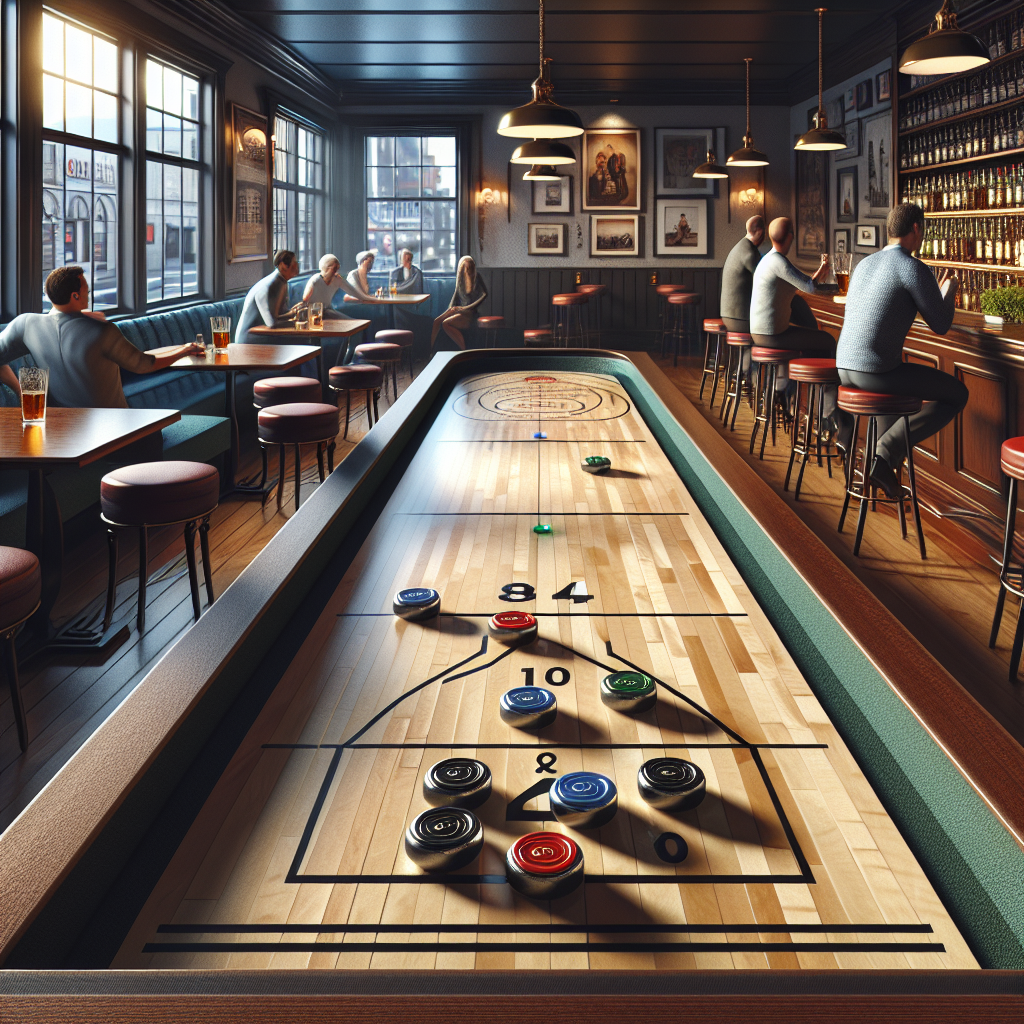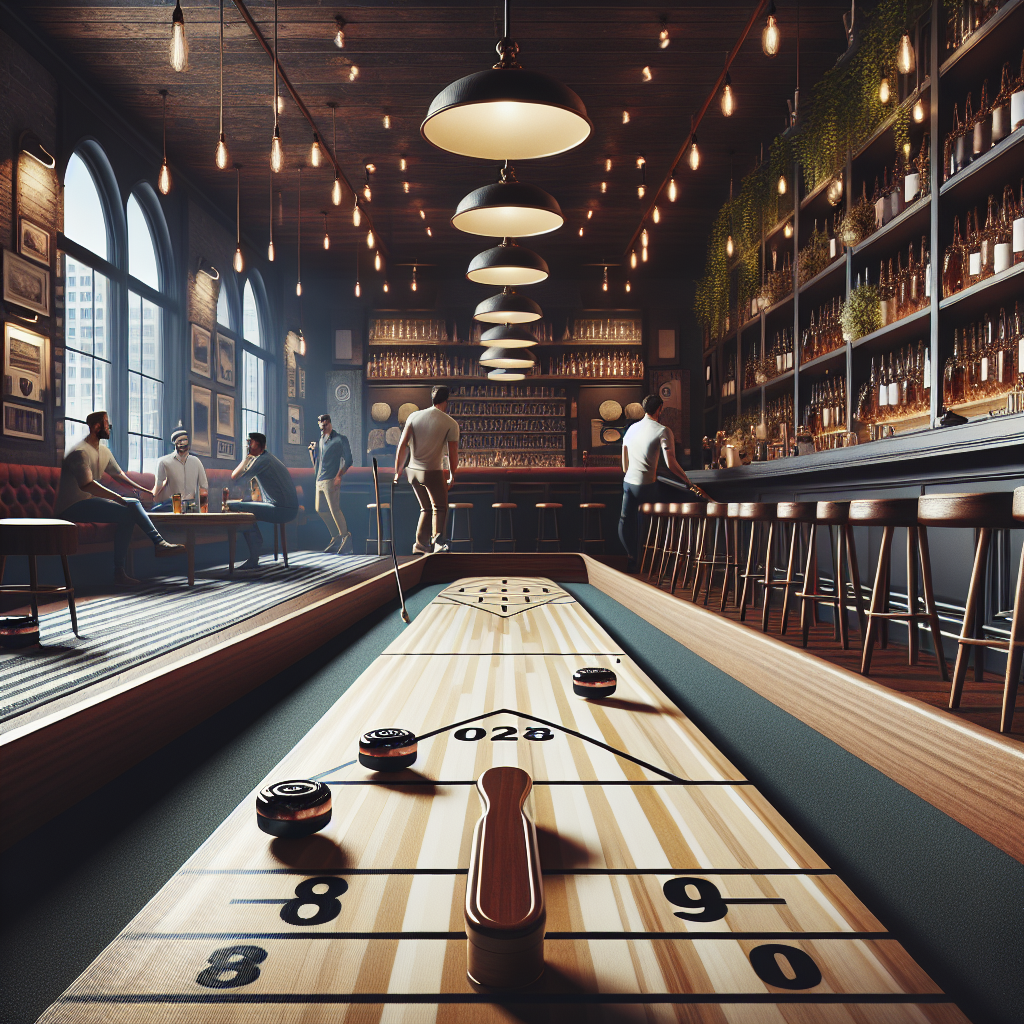Understanding Shuffleboard Basics
Before diving into the intricacies of bar shuffleboard rules, it’s important to grasp the fundamental aspects of the game. This section will provide an overview of the shuffleboard game and explain the different shots involved.
Shuffleboard Game Overview
Shuffleboard is a popular bar game played on a long, smooth table known as a shuffleboard table. The objective of the game is to slide weighted pucks, also called weights, down the length of the table, aiming to land them in scoring areas without falling off the board.
Players take turns sliding their weights against their opponents’ weights, strategically maneuvering to achieve the highest possible score. The game is typically played to either 15 or 21 points, with players alternating their turns until a predetermined score is reached.
Shuffleboard Shots Explained
To succeed in shuffleboard, players must master different types of shots. Each shot serves a specific purpose in gameplay. Here are some common shuffleboard shots:
- Side-Wheeling Shot: This shot involves releasing the weight with a slight spin, aiming to curve around existing weights and land in a desired scoring area.
- Free Shot: A straightforward shot where the weight is released without any spin or manipulation, aiming for optimal positioning on the board.
- Knock-Off Shot: This shot aims to displace an opponent’s weight from a scoring position, increasing the player’s chances of scoring higher.
- English/Spin Shot: By adding spin or English to the weight, players can manipulate its trajectory, making it more challenging for opponents to react.
- Bump Shot: This shot involves gently bumping or nudging an opponent’s weight to either change its position or knock it off the scoring area.
- Stick Shot: A technique where players use a cue stick with a cup-shaped attachment to propel the weights down the shuffleboard table.
- Guard/Safe Shot: This shot strategically places a weight in a position that obstructs opponents from achieving high-scoring positions.
Understanding and mastering these different shots is crucial for success in bar shuffleboard. By utilizing a combination of techniques and strategies, players can outmaneuver their opponents and secure higher scores.
As we delve deeper into bar shuffleboard rules, we’ll explore the specifics of scoring, determining the first shooter, frame completion, and other regulations that shape the gameplay. Stay tuned to enhance your knowledge and improve your skills in this exciting bar game.
Key Shuffleboard Rules
To become a master of bar shuffleboard, it’s essential to understand the key rules of the game. This section will cover scoring and winning, determining the first shooter, and frame completion and match rules.
Scoring and Winning
Shuffleboard games are usually played to either 15 or 21 points. Players alternate sliding all four of their weights against their opponent’s weights, aiming to reach the highest scoring area without falling off the board. The scoring is based on counting the pucks closest to the end of the table that are of the same color. Only the farthest pucks of the same color count towards the score, with their value determined by the score zone they occupy. Pucks hanging off the edge of the farthest zone are called “hangers” and are worth an extra point (McClure Tables, Shuffleboard.net).
| Scoring Zone | Points |
|---|---|
| 1 | 1 |
| 2 | 2 |
| 3 | 3 |
Determining the First Shooter
To determine the first shooter in shuffleboard, a coin is flipped. The winner then selects their preferred color and decides whether to shoot first or last, known as the “hammer.” Subsequently, players take turns shooting their colored pucks until all eight pucks have been shot in a round.
Frame Completion and Match Rules
In shuffleboard, a frame is completed when one side reaches 15 points. Matches typically consist of three frames. The game can be played one-on-one or in teams, with team play involving players taking turns by playing every other round. The player or team with the highest total points after three frames wins the match (Shuffleboard.net).
Understanding these key shuffleboard rules sets the foundation for a successful game. As you become more familiar with the game, you can start to develop strategies to outmaneuver your opponents and aim for victory. For more tips and techniques on how to improve your bar shuffleboard game, check out our articles on bar shuffleboard strategy, bar shuffleboard techniques, and bar shuffleboard tips. And if you’re interested in the equipment needed to play shuffleboard, don’t miss our article on bar shuffleboard equipment and bar shuffleboard maintenance.
Strategies for Shuffleboard Success
To master the game of shuffleboard, players need to develop effective strategies that can give them an edge over their opponents. Here are three key strategies that can lead to success in shuffleboard:
Knocking Off Opponents’ Weights
One of the fundamental strategies in shuffleboard is knocking off your opponents’ weights. By strategically aiming your shots, you can displace your opponents’ weights from high-scoring positions, preventing them from accumulating points. This strategy not only helps you gain an advantage but also disrupts your opponents’ game plan.
To effectively knock off opponents’ weights, observe their positioning and aim for weights that are in scoring positions. By doing so, you can create openings and potentially score points for yourself. Remember to consider the angles and rebounds to maximize the chances of successfully displacing opponents’ weights.
Outdistancing Opponents
Another strategy for success in shuffleboard is outdistancing your opponents. This involves shooting your weights with enough force to push them farther down the board than your opponents’ weights. By consistently outdistancing your opponents, you can control the scoring positions and make it more challenging for them to score points.
To outdistance opponents, focus on developing consistent and accurate shots. By practicing your technique and mastering the weight of the puck, you can achieve the desired distance with each shot. Analyze the speed and force required to push your weights past your opponents’ weights, and adjust your shots accordingly.
Protecting High-Scoring Weights
In shuffleboard, protecting your high-scoring weights is crucial to maintaining a strong position in the game. This strategy involves strategically placing your weights in positions that make it difficult for your opponents to knock them off or score points. By protecting your high-scoring weights, you can secure valuable points and maintain control of the game.
To protect your high-scoring weights, consider the positioning and angles on the board. Strategically place your weights in positions that block your opponents’ shots or limit their scoring opportunities. Use the board’s boundaries and your opponents’ weights to create barriers that make it challenging for them to displace or score against your weights.
By implementing these strategies, players can enhance their performance in shuffleboard and increase their chances of success. Remember that shuffleboard rules may vary based on the specific game being played, so it’s essential to familiarize yourself with the rules of the particular shuffleboard game you’re playing. For more advanced techniques and strategies, explore tournament rules and other variations.
Exploring Shuffleboard Variations
Shuffleboard is not limited to a single game. There are several variations of shuffleboard that can be played, each with its own set of rules and gameplay dynamics. In this section, we will explore different shuffleboard games, tournament rules, and gameplay on varying table sizes.
Different Shuffleboard Games
Shuffleboard offers a variety of games that cater to different skill levels and preferences. Some popular shuffleboard games include Knock Off Shuffleboard, Horse Collar Table Shuffleboard, Tap & Draw Shuffleboard, How To Play Shuffleboard Crazy Eight Rules, and Target Table Shuffleboard. Each game has its own unique rules and scoring mechanisms, providing an enjoyable experience for players of all levels.
Tournament Rules
Shuffleboard tournaments follow specific rules and regulations to ensure fair competition and consistent gameplay. While the exact rules may vary depending on the tournament, there are common guidelines that govern tournament play. These rules cover aspects such as scoring, fouls, time limits, and player conduct. It’s important for participants to familiarize themselves with the specific tournament rules before competing to ensure a level playing field.
Gameplay on Varying Table Sizes
Shuffleboard tables come in various sizes, offering different gameplay experiences. The standard shuffleboard table is typically 22 feet long by 20 inches wide, with scoring areas at each end marked with “1”, “2”, and “3” sections (Legacy Billiards). However, there are smaller and larger tables available to suit different spaces and preferences.
When it comes to outdoor shuffleboard tables, sizes typically range from 9 feet to 22 feet and are designed with all-weather qualities (Shuffleboard.net). The length of the table can significantly impact the gameplay experience. Longer tables provide a similar feel to a full-length table and allow for more challenging shots and strategies.
It’s important to note that the size of the shuffleboard table can affect the overall gameplay and skill development. Smaller tables can be suitable for practice and skill improvement, especially in situations where space constraints exist. However, for the optimal shuffleboard experience, a 22-foot table is considered ideal (Shuffleboard.net).
By exploring different shuffleboard games, understanding tournament rules, and considering the table size, players can enjoy the diverse and exciting world of shuffleboard. Whether you’re competing in a tournament or playing with friends, these variations offer unique challenges and opportunities for strategic play.
Selecting the Right Shuffleboard Table
To fully enjoy the game of bar shuffleboard, selecting the right shuffleboard table is crucial. There are several factors to consider when choosing a shuffleboard table, including regulation size, table length, and ensuring a proper fit in the designated space.
Regulation Table Size
Regulation shuffleboard tables are typically 22 feet in length and 20 inches wide. This size is considered the standard for competitive play and provides players with an authentic shuffleboard experience. The dimensions of a regulation table ensure that players have enough space to execute shots accurately and play according to bar shuffleboard rules. The exact measurements of a regulation table allow for fair and consistent gameplay.
Choosing Table Length
While regulation tables are 22 feet in length, shuffleboard tables are available in various lengths ranging from 8 feet to 22 feet. The length of the table will impact the gameplay experience. Longer tables provide a similar feel to a full-length table, allowing players to hone their skills and technique. However, if space constraints exist, smaller shuffleboard tables can still offer a suitable practice surface for skill development.
When choosing the length of a shuffleboard table, it’s important to consider the available space and the desired level of gameplay. Keep in mind that larger tables require more room for optimal gameplay experience. If space is limited, a smaller table can still provide enjoyment and entertainment.
Ensuring Proper Fit
Before purchasing a shuffleboard table, it is essential to measure the dimensions of the space where it will be placed. This includes considering factors such as clearance, room for spectators, and distance from fragile items. A minimum of 2 feet clearance on both ends of the table is recommended for an optimal gameplay experience.
It’s important to ensure that the selected shuffleboard table can fit through doorways and into the desired room. Measure the available space, including door dimensions, elevator access, and clearance around corners, to avoid any issues with delivery and installation. Opting for a slightly smaller table may be necessary to ensure it fits into the designated space without complications.
To make the process of selecting a shuffleboard table easier, platforms like Shuffleboard.net offer a variety of tables that can be filtered by size, making it convenient for customers to find options that fit their available space. These platforms also provide assistance with shipping coordination, ensuring a hassle-free ordering process.
By considering the regulation table size, choosing the appropriate table length, and ensuring a proper fit in the designated space, you can select a shuffleboard table that enhances your bar shuffleboard experience. Remember to also familiarize yourself with bar shuffleboard rules, strategies, and techniques to master the game and have hours of fun with family and friends.
History and Evolution of Shuffleboard
Shuffleboard has a rich history that dates back centuries. Understanding the origins and evolution of this popular game provides valuable context for players and enthusiasts alike.
Origins of Shuffleboard
Shuffleboard traces its roots to 15th-century England, where it originated as a game called “Shoffe-Groat” (Legacy Billiards). In this early version of the game, players would slide a large 4-pence coin down a long table, aiming to get the coin as close to the edge as possible without it falling off. Over time, the game evolved and gained popularity among early American colonists.
During the reign of King Henry VIII, shuffleboard was actually outlawed for commoners, as the king believed it distracted them from their daily duties. However, it continued to be enjoyed and even mentioned in the play “The Crucible,” which centered around the Salem Witch Trials in 1692 (Legacy Billiards).
Evolution Through the Centuries
Shuffleboard has seen significant evolution and adaptation over the centuries. In the 1848 legal case, The State vs. John Bishop, shuffleboard was officially recognized as a game of skill rather than chance. This ruling allowed tavern owners like John Bishop to continue operating shuffleboard games without requiring a license.
As the game gained popularity, various forms and variations emerged. Different regions developed their own unique versions of shuffleboard, each with its own set of rules and variations. This led to the creation of different shuffleboard games that are played around the world today.
Modern Shuffleboard Associations
In the 1990s, the Table Shuffleboard Association (TSA) was formed to promote and organize shuffleboard competitions. The TSA established a hall of fame to honor the best players in the sport, further elevating the status of shuffleboard as a competitive game (Legacy Billiards).
Today, shuffleboard continues to evolve and thrive. Modern shuffleboard associations and leagues provide opportunities for players of all skill levels to compete and showcase their abilities. The game has also gained popularity as a recreational activity in bars, clubs, and social gatherings.
By understanding the history and evolution of shuffleboard, players can appreciate the legacy of this beloved game. Whether enjoying a casual game with friends or participating in competitive tournaments, shuffleboard offers a unique and engaging experience for players of all ages.








